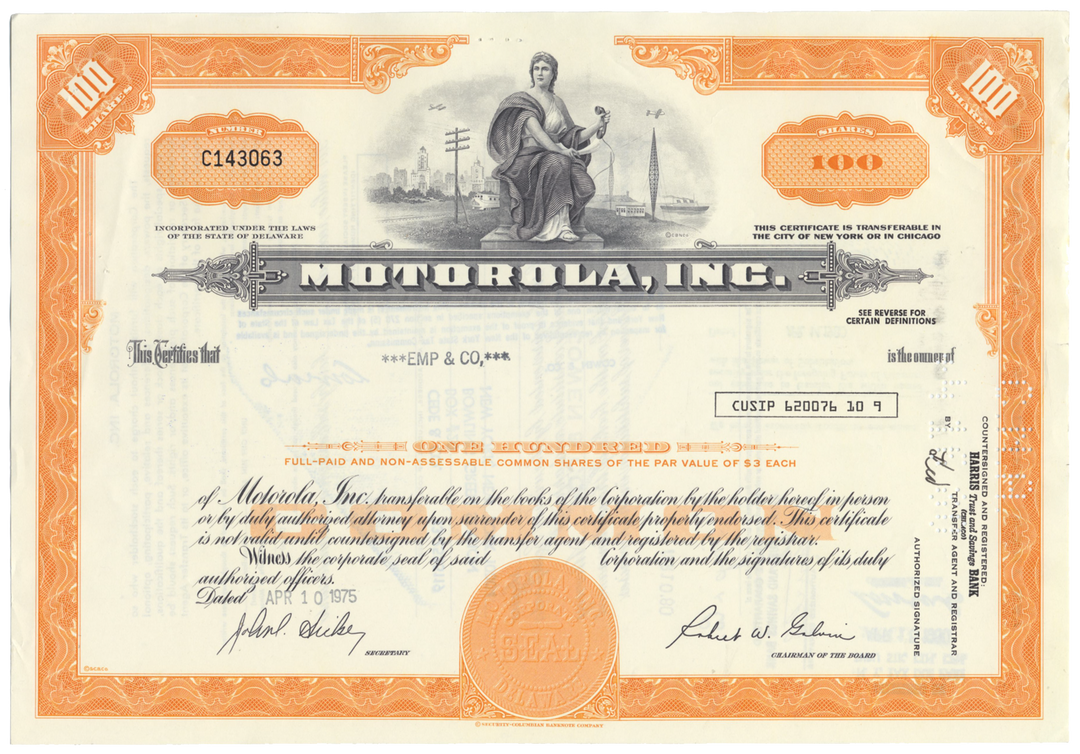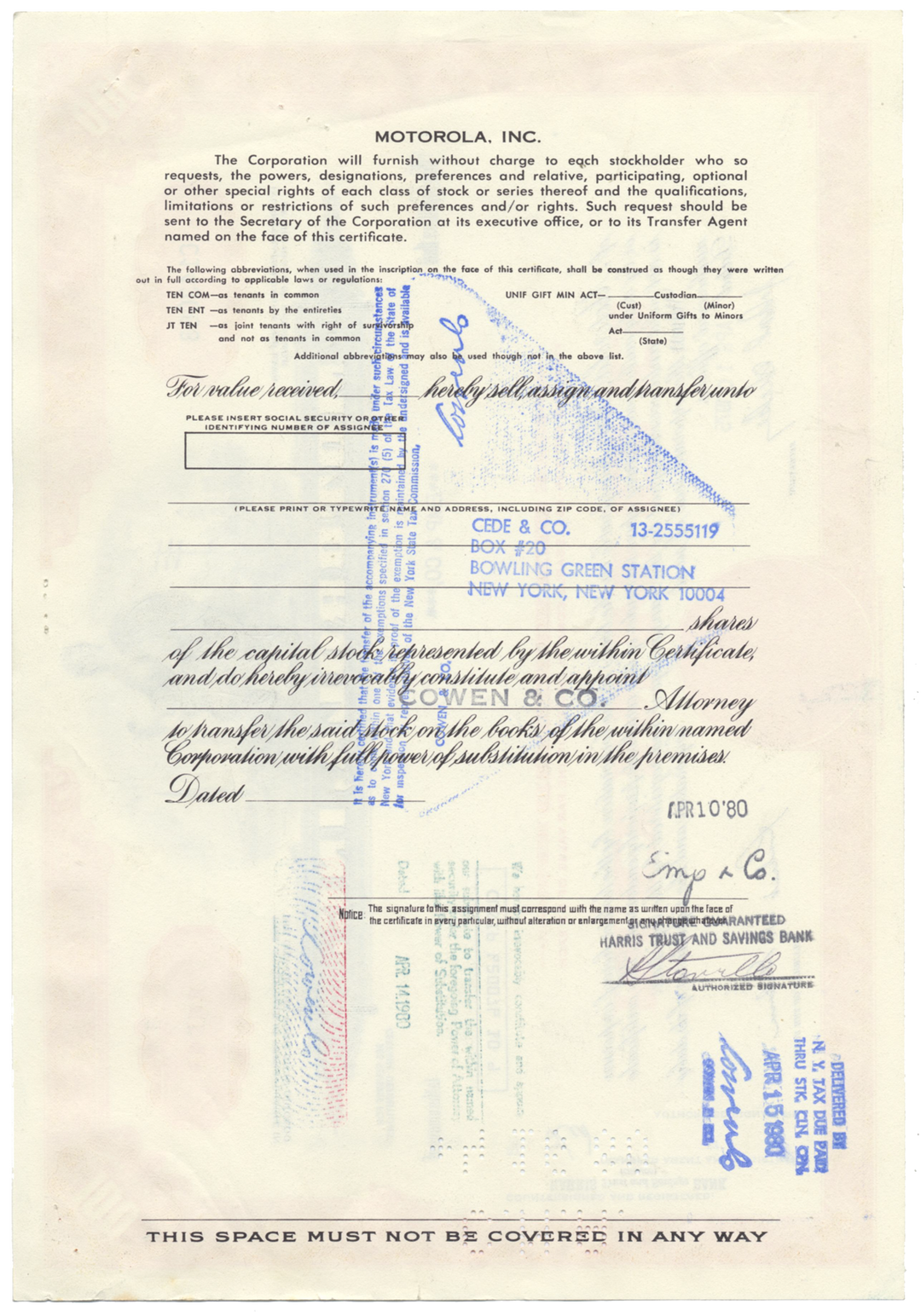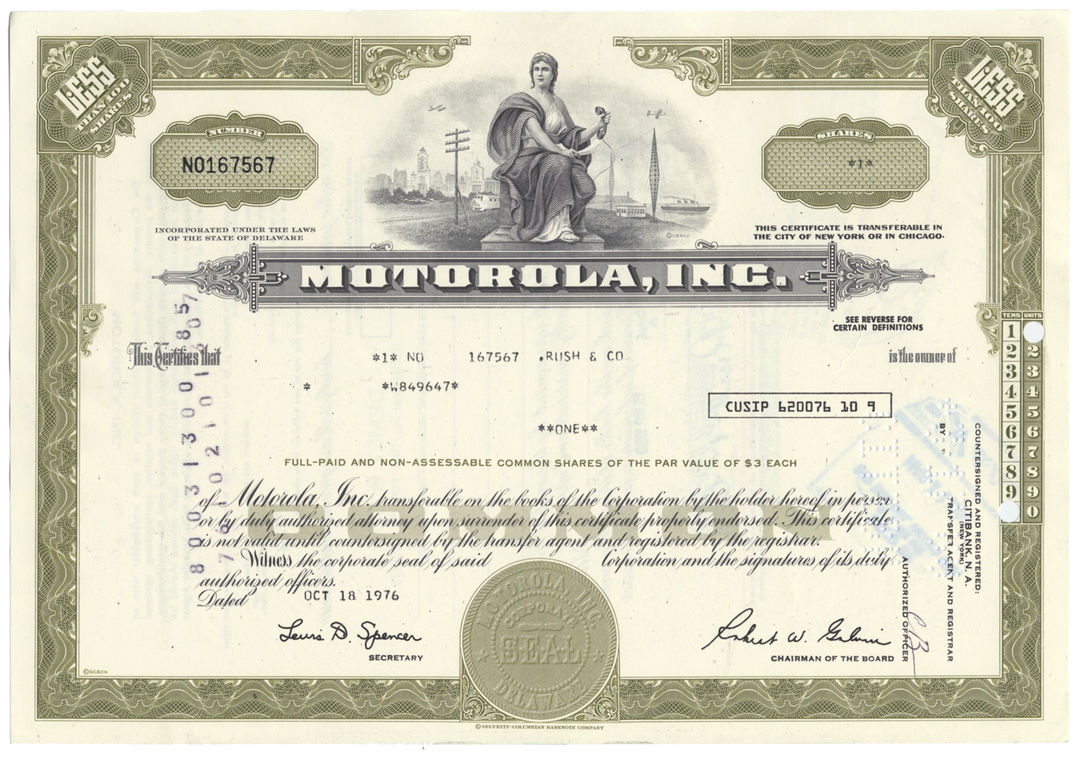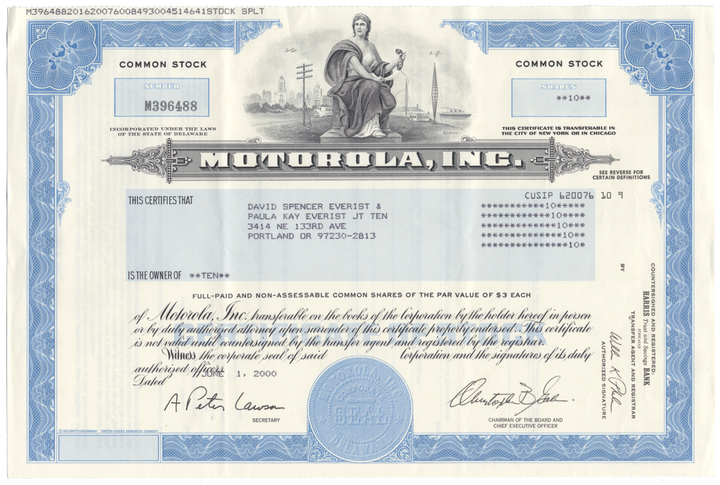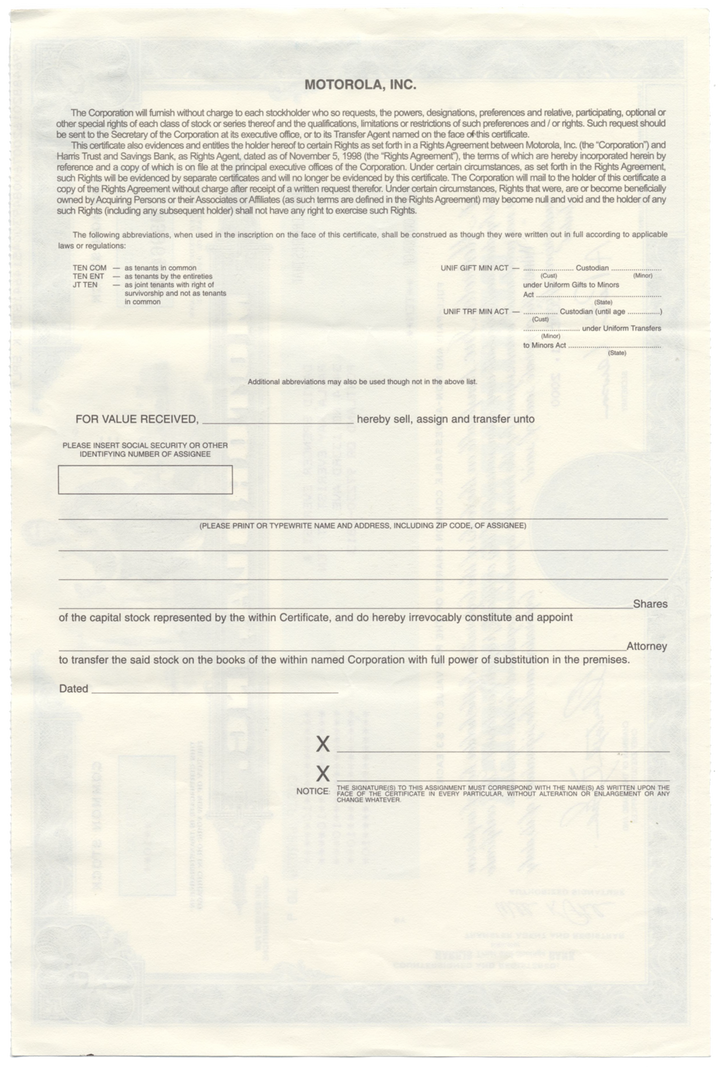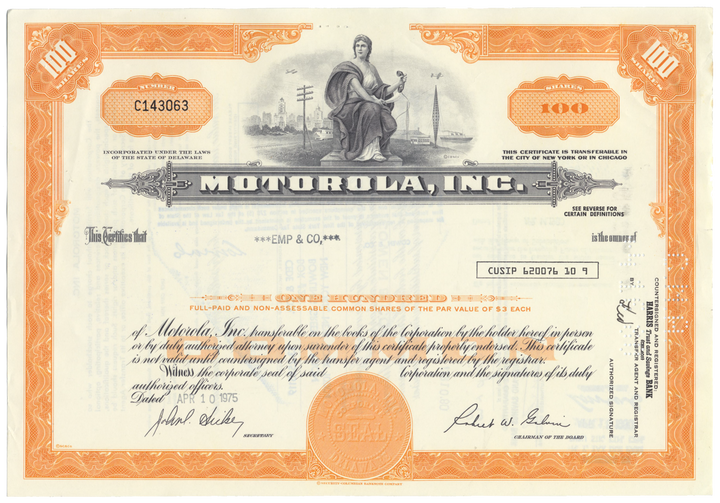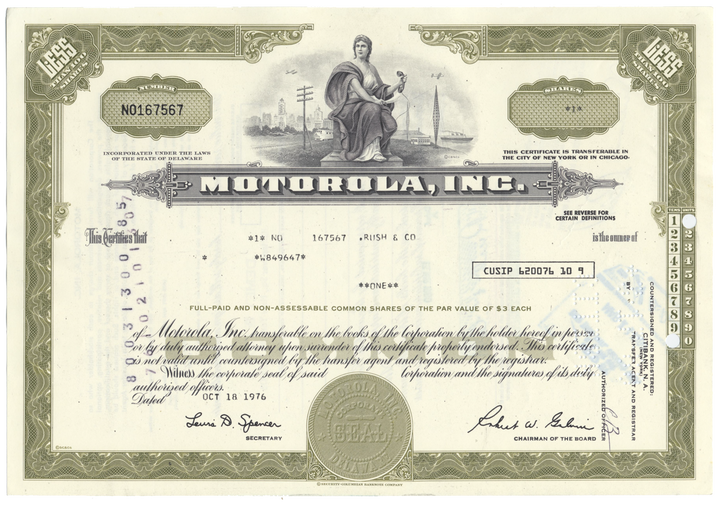Motorola, Inc.
- Guaranteed authentic document
- Orders over $75 ship FREE to U. S. addresses
Product Details
| Company | Motorola, Inc. |
| Certificate Type | Common Stock |
| Date Issued | June 1, 2000 (blue) April 10, 1975 (orange) October 18, 1976 (olive) |
| Canceled | Yes |
| Printer | Security-Columbian Bank Note Company |
| Signatures | Machine printed |
| Approximate Size |
12" (w) by 8" (h) |
|
Product Images |
Show the exact certificate you will receive |
| Authentic | Yes |
| Additional Details | NA |
Historical Context

Motorola started in Chicago, Illinois, as Galvin Manufacturing Corporation (at 847 West Harrison Street) in 1928 when brothers Paul V. and Joseph E. Galvin purchased the bankrupt Stewart Battery Company's battery-eliminator plans and manufacturing equipment at auction for $750. Galvin Manufacturing Corporation set up shop in a small section of a rented building. The company had $565 in working capital and five employees. The first week's payroll was $63.
The company's first products were the battery eliminators, devices that enabled battery-powered radios to operate on household electricity. Due to advances in radio technology, battery-eliminators soon became obsolete. Paul Galvin learned that some radio technicians were installing sets in cars, and challenged his engineers to design an inexpensive car radio that could be installed in most vehicles. His team was successful, and Galvin was able to demonstrate a working model of the radio at the June 1930 Radio Manufacturers Association convention in Atlantic City, New Jersey. He brought home enough orders to keep the company in business.
Paul Galvin wanted a brand name for Galvin Manufacturing Corporation's new car radio, and created the name “Motorola” by linking "motor" (for motorcar) with "ola" (from Victrola), which was also a popular ending for many companies at the time, e.g. Moviola, Crayola. The company sold its first Motorola branded radio on June 23, 1930, to Herbert C. Wall of Fort Wayne, Indiana, for $30. Wall went on to become one of the first Motorola distributors in the country. The Motorola brand name became so well known that Galvin Manufacturing Corporation later changed its name to Motorola, Inc.
Galvin Manufacturing Corporation began selling Motorola car-radio receivers to police departments and municipalities in November 1930. The company's first public safety customers (all in the state of Illinois) included the Village of River Forest, Village of Bellwood Police Department, City of Evanston Police, Illinois State Highway Police, and Cook County (Chicago area) Police with one-way radio communication. In the same year, the company built its research and development program with Dan Noble, a pioneer in FM radio and semiconductor technologies, who joined the company as director of research. The company produced the hand-held AM SCR-536 radio during World War II, which was vital to Allied communication. Motorola ranked 94th among United States corporations in the value of World War II military production contracts.
Motorola went public in 1939, and became Motorola, Inc. in 1947. At that time Motorola's main business was producing and selling televisions and radios.
In October 1946, Motorola communications equipment carried the first calls on Illinois Bell telephone company's new car radiotelephone service in Chicago. The company began making televisions in 1947, with the model VT-71 with 7-inch cathode ray tube. In 1952, Motorola opened its first international subsidiary in Toronto, Ontario, Canada to produce radios and televisions. In 1953, the company established the Motorola Foundation to support leading universities in the United States.
In 1955, years after Motorola started its research and development laboratory in Phoenix, Arizona, to research new solid-state technology, Motorola introduced the world's first commercial high-power germanium-based transistor. The present "batwing" logo was also introduced in 1955 (having been created by award-winning Chicago graphic designer Morton Goldsholl in late 1954).
Beginning in 1958, with Explorer 1 Motorola provided radio equipment for most NASA space-flights for decades, including the 1969 Moon landing. A year later it established a subsidiary to conduct licensing and manufacturing for international markets. Motorola created numerous products for use by the government, public safety officials, business installments, and the general public.
In 1960, it introduced the world's first large-screen portable (19-inch), transistorized, cordless television. According to the 1962 Illinois Manufacturers Directory (50th-anniversary edition), Motorola had 14,000 employees worldwide of which at least 5,823 employees in 6 plants were located in Illinois. The company headquarters were at 9401 West Grand Avenue in Franklin Park and it listed TV receivers, stereo hi-fi equipment as the products at this plant made by 1,700 employees. The Communications Division was in Chicago at 4545 West Augusta Blvd. where 2,000 employees made electronic communications equipment. The Military Electronics Division was at 1450 North Cicero Avenue, Chicago where 923 employees made microwave and industrial equipment. Two more Chicago locations were listed at 4900 West Flourney Street and at 650 North Pulaski but no employee count was listed for these. The last plant was listed in Quincy, Illinois at 1400 North 30th Street where 1,200 employees made radio assemblies for both home and automobile.
In 1963, it introduced the first rectangular color picture tube. In 1964, the company opened its first Research and development branch outside of the United States, in Israel, under the management of Moses Basin. The modular Quasar brand was introduced in 1967.
In 1969, Neil Armstrong spoke the famous words "one small step for man, one giant leap for mankind" from the Moon on a Motorola transceiver.
In 1971, Motorola demonstrated the first hand-held portable telephone.
In 1980, Motorola's next generation 32-bit microprocessor, the MC68000, led the wave of technologies that spurred the computing revolution in 1984, powering devices from companies such as Apple, Commodore, Atari, Sun, and Hewlett Packard.
Dr. Martin Cooper of Motorola made the first private handheld mobile phone call on a larger prototype model in 1973. This is a reenactment in 2007.
In September 1983, the U.S. Federal Communications Commission (FCC) approved the DynaTAC 8000X telephone, the world's first commercial cellular device. By 1998, cell phones accounted for two-thirds of Motorola's gross revenue. The company was also strong in semiconductor technology, including integrated circuits used in computers. In particular, it is known for the 6800 family and 68000 family of microprocessors and related peripheral ICs; the processors were used in Atari ST, Commodore Amiga, Color Computer, and Apple Macintosh personal computers and in the early HP laser printers, and some 6800-family peripheral devices were used in the IBM PC series of personal computers. The PowerPC family was developed with IBM and in a partnership with Apple (known as the AIM alliance). Motorola also has a diverse line of communication products, including satellite systems, digital cable boxes and modems.
Related Collections
Additional Information
Certificates carry no value on any of today's financial indexes and no transfer of ownership is implied. All items offered are collectible in nature only. So, you can frame them, but you can't cash them in!
All of our pieces are original - we do not sell reproductions. If you ever find out that one of our pieces is not authentic, you may return it for a full refund of the purchase price and any associated shipping charges.








